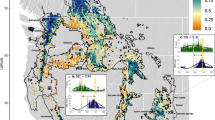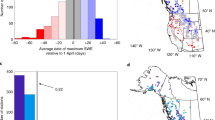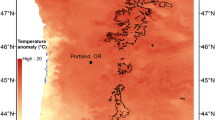Abstract
Snow accumulation is critical for water availability in the Northern Hemisphere1,2, raising concern that global warming could have important impacts on natural and human systems in snow-dependent regions1,3. Although regional hydrologic changes have been observed (for example, refs 1, 3, 4, 5), the time of emergence of extreme changes in snow accumulation and melt remains a key unknown for assessing climate-change impacts3,6,7. We find that the CMIP5 global climate model ensemble exhibits an imminent shift towards low snow years in the Northern Hemisphere, with areas of western North America, northeastern Europe and the Greater Himalaya showing the strongest emergence during the near-term decades and at 2 °C global warming. The occurrence of extremely low snow years becomes widespread by the late twenty-first century, as do the occurrences of extremely high early-season snowmelt and runoff (implying increasing flood risk), and extremely low late-season snowmelt and runoff (implying increasing water stress). Our results suggest that many snow-dependent regions of the Northern Hemisphere are likely to experience increasing stress from low snow years within the next three decades, and from extreme changes in snow-dominated water resources if global warming exceeds 2 °C above the pre-industrial baseline.
This is a preview of subscription content, access via your institution
Access options
Subscribe to this journal
Receive 12 print issues and online access
$209.00 per year
only $17.42 per issue
Buy this article
- Purchase on Springer Link
- Instant access to full article PDF
Prices may be subject to local taxes which are calculated during checkout



Similar content being viewed by others
References
Barnett, T. P., Adam, J. C. & Lettenmaier, D. P. Potential impacts of a warming climate on water availability in snow-dominated regions. Nature 438, 303–309 (2005).
Viviroli, D., Durr, H. H., Messerli, B., Meybeck, M. & Weingartner, R. Mountains of the world, water towers for humanity: Typology, mapping, and global significance. Wat. Resour. Res. 43, 1–13 (2007).
Stewart, I. T. Changes in snowpack and snowmelt runoff for key mountain regions. Hydrol. Process. 23, 78–94 (2009).
Barnett, T. P. et al. Human-induced changes in the hydrology of the western United States. Science 319, 1080–1083 (2008).
Choi, G., Robinson, D. A. & Kang, S. Changing Northern Hemisphere snow seasons. J. Clim. 23, 5305–5310 (2010).
Gardelle, J., Berthier, E. & Arnaud, Y. Slight mass gain of Karakoram glaciers in the early twenty-first century. Nature Geosci. 5, 322–325 (2012).
Mote, P. W., Hamlet, A. F., Clark, M. P. & Lettenmaier, D. P. Declining mountain snowpack in western north America. Bull. Am. Meteorol. Soc. 86, 39–49 (2005).
Kurz, W. A. et al. Mountain pine beetle and forest carbon feedback to climate change. Nature 452, 987–990 (2008).
Westerling, A. L., Hidalgo, H. G., Cayan, D. R. & Swetnam, T. W. Warming and earlier spring increase western US forest wildfire activity. Science 313, 940–943 (2006).
Kelly, A. E. & Goulden, M. L. Rapid shifts in plant distribution with recent climate change. Proc. Natl Acad. Sci. USA 105, 11823–11826 (2008).
Gornall, J. et al. Implications of climate change for agricultural productivity in the early twenty-first century. Phil. Trans. R. Soc. B 365, 2973–2989 (2010).
Rood, S. B. et al. Declining summer flows of Rocky Mountain rivers: Changing seasonal hydrology and probable impacts on floodplain forests. J. Hydrol. 349, 397–410 (2008).
Schroter, D. et al. Ecosystem service supply and vulnerability to global change in Europe. Science 310, 1333–1337 (2005).
Cayan, D. R. Interannual climate variability and snowpack in the western United States. J. Clim. 9, 928–948 (1996).
Scherrer, S. C. & Appenzeller, C. Swiss Alpine snow pack variability: Major patterns and links to local climate and large-scale flow. Clim. Res. 32, 187–199 (2006).
Taylor, K. E., Stouffer, R. J. & Meehl, G. A. An overview of CMIP5 and the experiment design. Bull. Am. Meteorol. Soc. 93, 485–498 (2012).
Moss, R. H. et al. The next generation of scenarios for climate change research and assessment. Nature 463, 747–756 (2010).
Rogelj, J., Meinshausen, M. & Knutti, R. Global warming under old and new scenarios using IPCC climate sensitivity range estimates. Nature Clim. Change 2, 248–253 (2012).
Kapnick, S. & Hall, A. Causes of recent changes in western North American snowpack. Clim. Dyn. 38, 1885–1899 (2011).
Bohr, G. S. & Aguado, E. Use of April 1 SWE measurements as estimates of peak seasonal snowpack and total cold-season precipitation. Wat. Resour. Res. 37, 51–60 (2001).
Meehl, G. A. in IPCC Climate Change 2007: The Physical Science Basis (eds Solomon, S. et al.) Ch. 10 (Cambridge Univ. Press, 2007).
Deser, C., Tomas, R., Alexander, M. & Lawrence, D. The seasonal atmospheric response to projected Arctic sea ice loss in the late twenty-first century. J. Clim. 23, 333–351 (2010).
Yin, J. H. A consistent poleward shift of the storm tracks in simulations of 21st century climate. Geophys. Res. Lett. 32, L18701 (2005).
Bookhagen, B. & Burbank, D. W. Toward a complete Himalayan hydrological budget: Spatiotemporal distribution of snowmelt and rainfall and their impact on river discharge. J. Geophys. Res. 115, F03019 (2010).
Ashfaq, M., Bowling, L. C., Cherkauer, K., Pal, J. S. & Diffenbaugh, N. S. Influence of climate model biases and daily-scale temperature and precipitation events on hydrological impacts assessment: A case study of the United States. J. Geophys. Res. 115, D14116 (2010).
Masson, D. & Knutti, R. Climate model genealogy. Geophys. Res. Lett. 38, L08703 (2011).
Boggs, C. L. & Inouye, D. W. A single climate driver has direct and indirect effects on insect population dynamics. Ecol. Lett. 15, 502–508 (2012).
Diffenbaugh, N. S. & Scherer, M. Observational and model evidence of global emergence of permanent, unprecedented heat in the 20th and 21st centuries. Clim. Change 107, 615–624 (2011).
Armstrong, R. L., Brodzik, M. J., Knowles, K. & Savoie, M. Global Monthly EASE-Grid Snow Water Equivalent Climatology (National Snow and Ice Data Center, Digital Media, 2007).
Giorgi, F. & Bi, X. Updated regional precipitation and temperature changes for the 21st century from ensembles of recent AOGCM simulations. Geophys. Res. Lett. 32, L21715 (2005).
Acknowledgements
Support for data storage and analysis was provided by the Center for Computational Earth and Environmental Sciences in the School of Earth Sciences at Stanford University. We acknowledge the World Climate Research Programme’s Working Group on Coupled Modelling, which is responsible for CMIP, and we thank the climate modelling groups (listed in Supplementary Table S1) for producing and making available their model output. For CMIP the US Department of Energy’s Program for Climate Model Diagnosis and Intercomparison provides coordinating support and led development of software infrastructure in partnership with the Global Organization for Earth System Science Portals. We thank the National Snow and Ice Data Center for providing the SWE data. Our work was supported by NSF award 0955283 and NIH award 1R01AI090159-01 to N.S.D., and ORNL LDRD 32112413 and DOE award ERKP777 to M.A.
Author information
Authors and Affiliations
Contributions
N.S.D. designed the climate model analysis, performed the climate model analysis and wrote the paper. M.S. designed the climate model analysis and performed the climate model analysis. M.A. designed the climate model analysis and wrote the paper.
Corresponding author
Ethics declarations
Competing interests
The authors declare no competing financial interests.
Supplementary information
Supplementary Information
Supplementary Information (PDF 9339 kb)
Rights and permissions
About this article
Cite this article
Diffenbaugh, N., Scherer, M. & Ashfaq, M. Response of snow-dependent hydrologic extremes to continued global warming. Nature Clim Change 3, 379–384 (2013). https://doi.org/10.1038/nclimate1732
Received:
Accepted:
Published:
Issue Date:
DOI: https://doi.org/10.1038/nclimate1732
This article is cited by
-
Evidence of human influence on Northern Hemisphere snow loss
Nature (2024)
-
Shifts in flood generation processes exacerbate regional flood anomalies in Europe
Communications Earth & Environment (2023)
-
Projections of North American snow from NA-CORDEX and their uncertainties, with a focus on model resolution
Climatic Change (2022)
-
Hatching phenology is lagging behind an advancing snowmelt pattern in a high-alpine bird
Scientific Reports (2021)
-
Evaluation of trends in extreme temperatures simulated by HighResMIP models across Europe
Climate Dynamics (2021)



